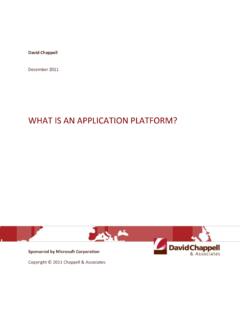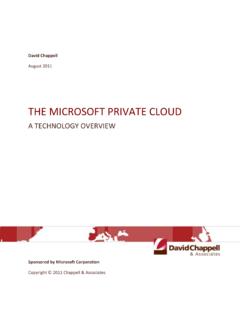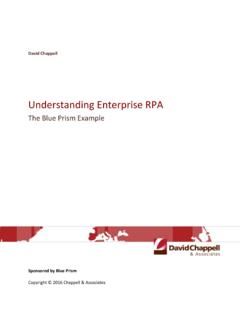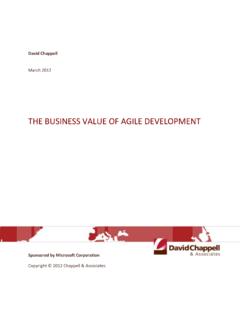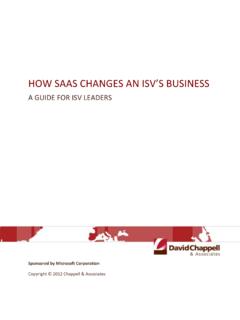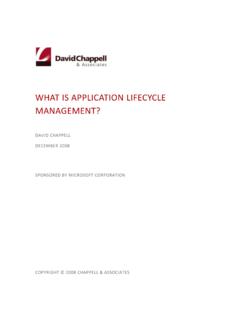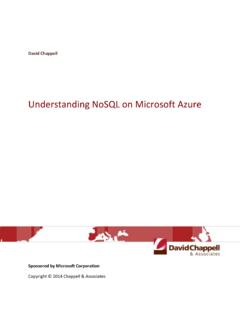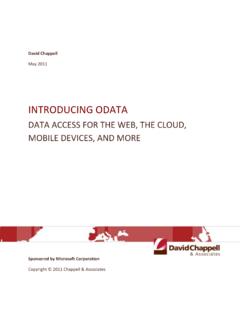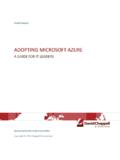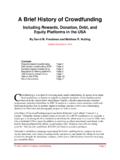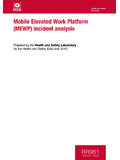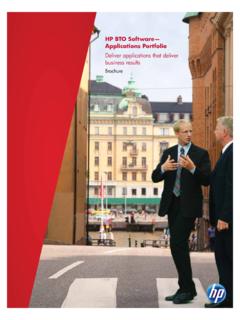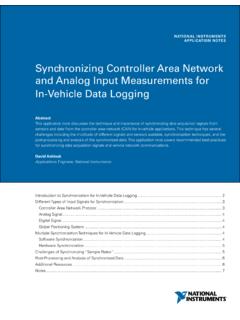Transcription of Building SaaS Applications on Windows Azure - …
1 David Chappell Building saas Applications ON Windows Azure THINGS TO THINK ABOUT BEFORE YOU START Sponsored by Microsoft Corporation Copyright 2012 Chappell & Associates 2 Contents Illustrating SaaP and saas .. 3 Design Issues for saas Applications .. 3 Multi-Tenancy ..3 Reliability and Scalability ..6 Security ..9 Metrics ..10 Design for Operations ..10 Portability ..11 APIs ..12 Customization ..13 Online Marketplaces ..15 Other Issues ..15 Conclusion .. 15 About the Author .. 16 3 Whether you re part of an established software vendor or a brand-new start-up, there s a good chance that your next application will run in the cloud. Doing this means embracing software as a service ( saas ), probably Building on a cloud platform such as Windows Azure .
2 But creating saas Applications is different from what you ve done before you need to think in new ways. This paper describes some of the most important things you should consider as you design your first saas application for Windows Azure . Illustrating SaaP and saas Before looking at a checklist of design issues, it s useful first to think about how saas Applications compare to on-premises Applications that use the traditional Software as a Product (SaaP) model. As Figure 1 shows, the two approaches differ in fundamental ways. Figure 1: saas Applications are different from traditional SaaP Applications . In the familiar SaaP world, each customer runs its own copy of an application, usually in its own datacenter. With saas , customers commonly share a copy of the application, and that application definitely isn t running in customer datacenters.
3 This apparently simple change in where an application runs and how it s shared turns out to have large implications for how you design and build the application. Design Issues for saas Applications Creating a saas application isn t simple, especially the first time you do it. What follows looks at some of the most important things you need to think about as you design your application. Multi-Tenancy The biggest decision you ll make in creating a saas application is whether your software will be single-tenant or multi-tenant. Figure 2 illustrates the difference. 4 Figure 2: A saas application can be single-tenant or multi-tenant. In a single-tenant application, each customer (such as a company or government agency) has its own instance of the application with its own distinct data storage.
4 In a multi-tenant application, multiple customers share an instance of the application and the data storage it relies on. Which approach is better depends on what you re trying to do each one has strengths and weaknesses. Figure 3 summarizes the main issues. Figure 3: Single- and multi-tenancy each have pros and cons. 5 The main points in this comparison are easy to summarize: Single-tenant Applications are easier to implement and to customize. This means they re typically faster and less expensive to create. They can also help customers feel more comfortable with the idea of saas , since many people are initially nervous about sharing code and storage with others. Beyond a certain number of customers, however, single-tenant Applications can become quite expensive to operate.
5 Multi-tenant Applications require more work to implement, and so they take more time and money to create. Multi-tenancy also requires convincing your customers that a shared application can keep their data safe, and that the application can provide enough customization to meet their needs. But multi-tenant Applications are significantly cheaper to operate over time, especially as the number of customers they serve goes up. For independent software vendors (ISVs) moving from the on-premises SaaP world to saas , one option is to start by deploying a single-tenant version of an existing application. Especially in enterprise markets, where customers commonly demand high levels of trust and customization, single tenancy can be a good choice. This approach also lets the ISV gauge whether there s really a demand for saas in this market before investing the time and money required to create a multi-tenant application.
6 But servicing a large number of customers with a single-tenant solution is likely to be prohibitively expensive. Because of this, creating a multi-tenant saas application is most often the right long-term goal for existing ISVs. This is especially true for ISVs hoping to target smaller organizations with a lower-cost saas offering. Providing a lower price means having lower expenses, which in turn implies multi-tenancy. For start-ups and anybody else creating a new saas application, starting with multi-tenancy is likely to make the most sense. Since your goal is to have lots of customers, why not design for this from the beginning? Unless you know your customers will have very stringent requirements for security or customization, multi-tenancy is the way to go.
7 Defining saas Some people believe that the term saas should be reserved solely for multi-tenant Applications . Single-tenant cloud Applications , they argue, are really examples of the older application service provider (ASP) model. Yet customers typically can t tell the difference. To them, an application that runs in the cloud and provides cloud-style pricing (such as per-user/per-month subscriptions) is saas , regardless of whether it s single- or multi-tenant. And since creating a single-tenant application is sometimes the right thing to do, including both options under the saas umbrella makes sense. 6 To think clearly about a multi-tenant saas application, it s important to understand that a tenant isn t just a billing relationship, , a customer.
8 Each tenant is also a unit of the following: Data isolation: Even though many customers are sharing a single application, each one expects its work to be isolated from work done by the others. In general, the most important part of this is keeping their data safe from prying eyes. It s entirely possible that their major competitor is also a user of your application, and they need to feel safe about sharing storage with this tenant. Performance: Even though a customer might know that he s using a shared application, he s unlikely to be happy if that application s performance varies significantly from day to day. Building an application that provides predictable performance with varying numbers of users isn t easy, but striving for this goal is nonetheless important.
9 Customization: Even though multi-tenant Applications don t typically allow modification of the application code itself, they do commonly provide facilities for customizing the app s behavior (a topic discussed in more detail later). This customization must be done on a per-tenant basis. Access: Whether the application is accessed through a web browser or via an API, that access must always send users to the right place with the right data. This requires thinking of identity and access control on a per-tenant basis. Reliability and Scalability Reliability is important for every application, SaaP or saas . Both kinds of Applications must also be scalable enough for the load they re expected to bear. With saas , however, both of these requirements become much more important.
10 To see why, look at Figure 1 again. With SaaP, each instance of the application supports users at just one organization. If it fails, only those users are affected. Similarly, the application s scalability requirements are limited by the number of users at its largest customer. With (multi-tenant) saas , however, a single instance supports many users at many companies. If the application fails, all of those users are unhappy. And the application s scalability requirements also go way up it s now required to handle all of the users at all of the tenants this instance supports. These changes are a big part of why creating a multi-tenant application takes more work. Providing both reliability and scalability for an application depends on a common architectural approach: multiple instances of everything.
